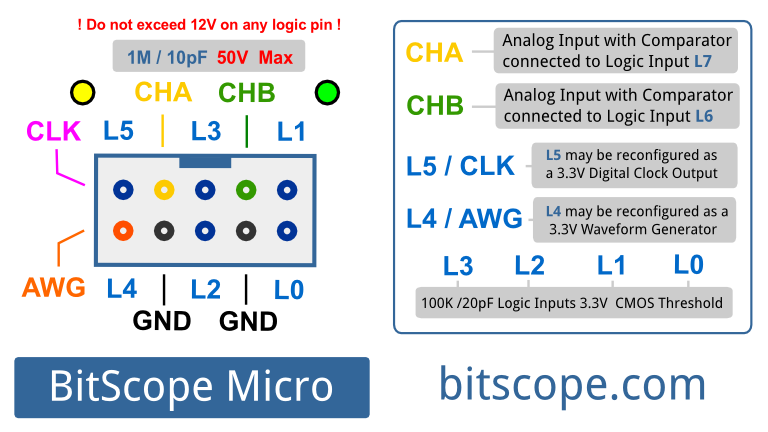
BitScopes as small as BS10 or as large as BS445 use an IDC-26 based Smart Port Interface for I/O.

This interface defines a standard way to access all BitScope's analog and digital signal inputs, outputs, power, ground and control signals. Most models also include waveform and clock generator outputs.
With the launch of BitScope Micro we wanted all the core functionality of Smart Port but in a much more compact 10-pin configuration.
The BitScope Micro Diagnostic Port is an IDC-10 based 10-pin alternative to the Smart Port. Whereas the Smart Port interface is designed for complete system I/O, the Micro Diagnostic Port is designed for compact multi-function mixed signal test & measurement, automated testing and passive signal monitoring.
It provides most of the functionality of the Smart Port but omits the power and dedicated control lines. Instead it offers reassignable signal routing and a sensible pin layout to enable access to all of BitScope's analog and digital inputs, waveform and clock generators for a wide range of test, measurement and data acquisition applications.
The BitScope Micro Port is custom designed for test & measurement. The instrument types it supports include:
The input signals are buffered allowing direct connection of test probes such as CLP-02 (included with BitScope Micro) to monitor analog and logic signals. The use of an IDC-10 connector makes it very easy to connect via ribbon cables or directly via test ports built into the monitored system or circuit under test.
The pin assignment and signal layout is no accident; the two ground pins a located adjacent to the analog inputs, three of the logic inputs and arbitrary waveform generator. This allows twisted pair connection to these signals using standard 2-pin connector. It also means a pair of 4-pin or a 4-pin and 6-pin connector will pick up their own ground line.
Most signals are reassignable and many share related functionality. For example, each analog channel is internally connected to a digital comparator. The comparator outputs are routed to logic channels L6 and L7 which means the (analog or digital) signals connected to the analog inputs can be captured to two logic channels at the same time. The switching level of these two logic channels can be adjusted making it possible to capture logic signals that switch at unusual levels. It's even possible to capture negative voltage or reversed polarity logic this way.
Pin connections for BitScope Micro Port:
| PIN | SIGNALS | DESCRIPTION |
| 1 | L5, CLK | Logic channel 5 or clock generator output. |
| 2 | L4, AWG | Logic channel 4 or waveform generator output. |
| 3 | L7, CHA | Analog channel A and Logic channel 7 (via programmable comparator). 1MΩ/10pF input impedance, bi-polar input with tri-state signal sensing. |
| 4 | GND | Analog channel A and left block ground signal. |
| 5 | L3, D3 | Logic channel 3 or Control signal 3. |
| 6 | L2, D2 | Logic channel 2 or Control signal 2. |
| 7 | L6, CHB | Analog channel B and Logic channel 6 (via programmable comparator). 1MΩ/10pF input impedance, bi-polar input with tri-state signal sensing. |
| 8 | GND | Analog channel B and right block ground signal. |
| 9 | L1, D1 | Logic channel 1 or Control signal 1. |
| 10 | L0, D0 | Logic channel 0 or Control signal 0. |
In addition to manual test & measurement, BitScope Micro is ideal for automated testing and diagnostics.
Logic channels 0 to 3 can be reconfigured under software control as outputs which can pull low. Up to 15 different "test vectors" can be defined this way or the signals used independently to configure or control the circuit under test.
If a matching connector is included on a system to be monitored one can connect BitScope Micro conveniently via a ribbon cable. In this way BitScope Micro can be used as a very low cost USB connected universal test system.
This solution scales well too; using BitScope Server, one Raspberry Pi B+ and four BitScope Micros one can create a network connected automated test system comprising 8 analog and 24 logic channels at very low cost.
And it's all customisable and fully user programmable. We'll post some examples soon!